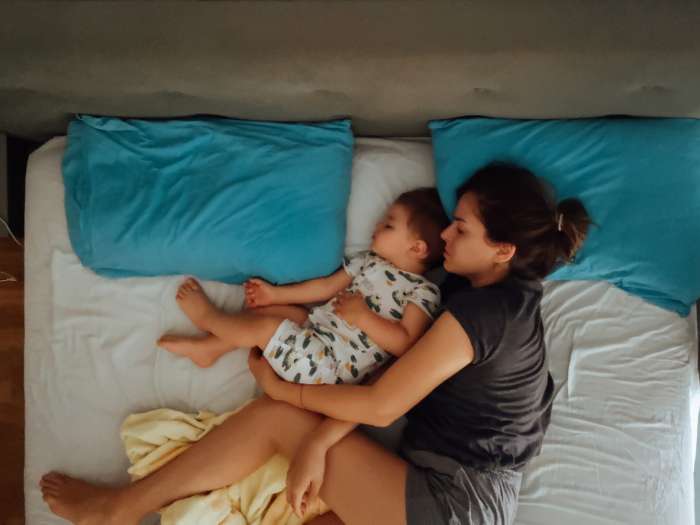Naps provide precious downtime for parents as well as toddlers. But naptime can’t last forever. All toddlers stop napping at some point — some earlier than others.
What’s the average age toddlers stop napping?
And how can you tell when your little one is ready to give up that afternoon snooze?
Related: Simple Steps to Ending Toddler Bedtime Struggles
Why Young Children Nap
Infants spend a lot of their time asleep. They typically need less rest time as they grow, but toddlers and young children still need more sleep than adults. Adults typically need eight hours of rest. But for small children, the numbers are quite different.
The Centers For Disease Control (CDC) lays it out like this:
What Age Do Kids Need Bed Rails and Bed Guards?
Transitioning to a big kid bed is a big deal for your little one...and for you too! It’s just another sign that they’re growing up. When your child makes the jump to a toddler bed or a twin bed, safety is priority number one. Read More
- Babies up to three months: 14 to 17 hours of sleep per 24-hour period
- Infants from four to 12 months: 12 to 16 hours, including naps
- Toddlers aged one to two years: 11 to 14 hours, including naps
- Preschoolers from two to five years: 10 to 13 hours, including naps
That said, some kids need less rest than others. Mine decided to drop naps completely at age two, while the child next door still took an afternoon nap at age six.
The best sleep schedule is the one that keeps your child’s mood and energy levels normal and allows them to get a good night’s sleep every night.
If you’re concerned about your child’s sleep schedule, your pediatrician is your first stop. They can answer any questions you might have, or refer you to a sleep consultant if necessary.
Signs Your Toddler May Be Ready to Stop Napping
Giving up the nap is an important sign of cognitive development. In fact, in three to five-year-olds, transitioning to exclusively sleeping at night is tied to higher vocabulary and cognitive development (Lam, 2011).
If your toddler is getting ready to give up their naps, you’ll notice a few telltale signs.
First, your child may wake up early in the morning. This may be because, between naps and their nighttime sleep, they’ve had more than enough rest by morning.
If you’re struggling to get your toddler to go down for naps, or they don’t stay asleep once they do go down, they may no longer need that nap.
Toddlers who take a long time to settle down at bedtime, or to fall asleep, may be getting too much sleep and may be ready to give up their naps.
If your toddler can skip a nap and keep going without any noticeable effects — no tantrums, crankiness, meltdowns, or sleepiness—then chances are, they can forego naptime altogether.
Signs Your Toddler is NOT Ready to Stop Napping

Some young children are eager to stop napping, but they may not be ready. Not having enough rest can negatively impact young children’s physical and emotional development. So how can you tell if your child needs those naps?
If your child becomes irritable when they skip their nap, they should probably still be napping.
Aggression can be a signal that a child is overtired, as can silliness or clumsiness.
If your toddler’s behavior becomes worse in the evenings, it may be because they’re overtired and need their nap.
And if your child is struggling to stay awake during the day, even after a full night of sleep, then a daytime nap can help.
Top Toddler Sleep Training Tips
Here are some tips from experts about developing a healthy sleep schedule with your child.
How Many Naps?
Babies sleep as needed — which may not always be the time that you need them to sleep! That said, children under one year of age may take one to four naps a day (Fry, 2023).
Toddlers often have a morning nap and an afternoon nap. Older toddlers may take a single daily nap, often in the afternoon.
By age six, 90 percent of children no longer nap. If your child is still napping at age seven, it’s worth discussing with your pediatrician.
Nap Duration
How can you tell if your child’s naps are too long or too short?
According to the Sleep Foundation, many toddlers between ages one and two can get by with an afternoon nap of around 60 minutes (Fry, 2023).
If your child takes a long nap and has trouble settling down to sleep at night, you might consider waking them up earlier from their nap. But if they can get a good night’s sleep after a long nap, there’s no need to shorten their naptime.
The Bedtime Routine
A regular bedtime is essential for healthy sleep. A toddler bedtime routine can help your child to develop healthy habits that meet their sleep needs. Here are a few things to consider adding to your routine.
Many children find a bath before bedtime both fun and relaxing. After their bath can be a good time to brush their teeth and use the toilet.
Does your child have a toddler bed? This scaled-down version of an adult bed can make your child feel like a big kid and look forward to bedtime.
Reading a story to your child has many proven benefits (Nicola, 2021), including brain development, language skills, and getting ready for literacy. It’s also a great way to simply connect with your child.
Once you turn the lights out, have a chat. You can talk about your day or any upcoming events that you’re looking forward to. Then say goodnight and tell them you’ll see them in the morning.
How to Transition From Naps
Every child is different. Some may stop napping one day and never go back. Other kids, on the other hand, may need a slower transition. And some children are ready to give up their naps before their parents are ready.
Quiet time can help in all of these cases.
Quiet time allows children to choose whether they’d like to sleep or engage in quiet activities. Some daycares and preschools have quiet time, which allows kids who still nap to get their rest without being disturbed, and heads off frustration from classmates who have outgrown daytime sleep.
Another benefit of quiet time is that it gives toddlers a bit more control over their lives and their schedules. Many children relish this increased control, as it signals that they’re on the road to becoming a big kid.
Like naptime, quiet time should take place in the same time and place, like in the child’s room. In fact, if they’re in the same room with their bed, they may choose to put themselves down for a nap if they need it.
There should also be a choice of stimulating (but quiet) activities for them to choose from, for example:
- Books to look at
- Age-appropriate puzzles
- Coloring
- Dolls, stuffed animals, toy vehicles, etc.
Try to keep the environment outside the quiet time space quiet as well, as loud noises may disturb your child’s peaceful environment, or cause them to come out to see what the excitement’s about.
Quiet time can help both you and your little one to rest and recharge. It can provide a transition between napping and staying awake all day. And it gives children greater control over their lives, which both makes them happy and helps them to develop responsibility and self-control.
Baby Sleep FAQ
Do you have questions? We have answers!
What is Sleep Regression?
Sleep regression is a change in your child’s nap or sleep routine. Babies who were sleeping through the night may suddenly wake up several times at night. Naptimes might shift, children may give up a nap, or they might start taking them again.
It can be frustrating, but most of the time it’s normal. Sleep regression can mean that your child is about to embark on a growth spurt or new stage of development.
What Time Should a Toddler Go To Bed?
Many toddlers do quite well with a bedtime of 7:00 to 8:00 pm. If they take an afternoon nap, it should end four to five hours before their evening bedtime. Remember that regularity is important for high-quality sleep.
Should I Wake My Toddler From Their Nap?
Maybe.
If their nap goes on for too long, they may not sleep well at night. On the other hand, if they sleep well at night, they may need that extra rest. Refer to the CDC’s advice above regarding the total number of sleep hours for children of different ages.
When Should I Speak to the Pediatrician?
If your child isn’t getting enough sleep, or if they’re sleeping too much, a chat with your pediatrician can help to clear things up.



